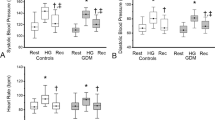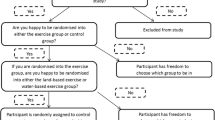Abstract
Objective
Formerly preeclamptic women with low plasma volume are at increased risk of recurrent gestational hypertensive disease. We hypothesized that a 4-week cycling training in formerly preeclamptic women improves (venous) hemodynamic function.
Methods
In 9 formerly preeclamptic women, we examined physical fitness and hemodynamic function, before and after the training. We assessed blood pressure, heart rate, cardiac output, plasma volume, and calf and forearm venous compliance.
Results
After the training, baseline blood pressure and cardiac output remained unchanged, but resting heart rate decreased (–7%, P = .02). Plasma volume was 8% higher after training (P = .01). Calf venous compliance increased (+18%, P = .02) but not forearm venous compliance (+14%, P = .09).
Conclusion
Cycling training improves venous vascular function in formerly preeclamptic women. The decreased resting heart rate and improvement of venous compliance suggest reduced sympathetic activity. These rapid exercise-induced changes may improve maternal vascular adaptation in early pregnancy and with it the risk of (recurrent) gestational hypertensive disease.
Similar content being viewed by others
References
Roberts JM, Pearson GD, Cutler JA, Lindheimer MD. Summary of the NHLBI working group on research on hypertension during pregnancy. Hypertens Pregnancy. 2003;22:109–127.
Sibai B, Dekker G, Kupferminc M. Pre-eclampsia. Lancet. 2005;365:785–199.
Spaanderman ME, Ekhart TH, van Eyck J, Cheriex EC, de Leeuw PW, Peeters LL. Latent hemodynamic abnormalities in symptom-free women with a history of preeclampsia. Am J Obstet Gynecol. 2000;182:101–107.
van Pampus MG, Dekker GA, Wolf H, et al. High prevalence of hemostatic abnormalities in women with a history of severe preeclampsia. Am J Obstet Gynecol. 1999;180:1146–1150.
Bellamy L, Casas JP, Hingorani AD, Williams DJ. Pre-eclampsia and risk of cardiovascular disease and cancer in later life: systematic review and meta-analysis. BMJ. 2007;335:974.
Germain AM, Romanik MC, Guerra I, et al. Endothelial dysfunction: a link among preeclampsia, recurrent pregnancy loss, and future cardiovascular events? Hypertension. 2007;49:90–95.
Aardenburg R, Spaanderman ME, Courtar DA, van Eijndhoven HW, de Leeuw PW, Peeters LL. A subnormal plasma volume in formerly preeclamptic women is associated with a low venous capacitance. J Soc Gynecol Investig. 2005;12:107–111.
Spaanderman ME, Willekes C, Hoeks AP, Ekhart TH, Peeters LL. The effect of pregnancy on the compliance of large arteries and veins in healthy parous control subjects and women with a history of preeclampsia. Am J Obstet Gynecol. 2000;183:1278–1286.
Aardenburg R, Spaanderman ME, Ekhart TH, van Eijndhoven HW, van der Heijden OW, Peeters LL. Low plasma volume following pregnancy complicated by pre-eclampsia predisposes for hypertensive disease in a next pregnancy. BJOG. 2003;110:1001–1006.
Spaanderman ME, Aardenburg R, Ekhart TH, et al. Non-pregnant circulatory volume status predicts subsequent pregnancy outcome in normotensive thrombophilic formerly preeclamptic women. Eur J Obstet Gynecol Reprod Biol. 2001;95:218–221.
Spaanderman M, Ekhart T, van Eyck J, de Leeuw P, Peeters L. Preeclampsia and maladaptation to pregnancy: a role for atrial natriuretic peptide? Kidney Int. 2001;60:1397–1406.
Banz WJ, Maher MA, Thompson WG, et al. Effects of resistance versus aerobic training on coronary artery disease risk factors. Exp Biol Med (Maywood). 2003;228:434–440.
Green DJ, Maiorana A, O’Driscoll G, Taylor R. Effect of exercise training on endothelium-derived nitric oxide function in humans. J Physiol. 2004;561:1–25.
Rudra CB, Williams MA, Lee IM, Miller RS, Sorensen TK. Perceived exertion during prepregnancy physical activity and preeclampsia risk. Med Sci Sports Exerc. 2005;37:1836–1841.
Sorensen TK, Williams MA, Lee IM, Dashow EE, Thompson ML, Luthy DA. Recreational physical activity during pregnancy and risk of preeclampsia. Hypertension. 2003;41:1273–1280.
Weissgerber TL, Wolfe LA, Davies GA. The role of regular physical activity in preeclampsia prevention. Med Sci Sports Exerc. 2004;36:2024–2031.
Sawka MN, Coyle EF. Influence of body water and blood volume on thermoregulation and exercise performance in the heat. Exerc Sport Sci Rev. 1999;27:167–218.
Schumacher YO, Schmid A, Grathwohl D, Bultermann D, Berg A. Hematological indices and iron status in athletes of various sports and performances. Med Sci Sports Exerc. 2002;34:869–875.
Hernandez JP, Franke WD. Age- and fitness-related differences in limb venous compliance do not affect tolerance to maximal lower body negative pressure in men and women. J Appl Physiol. 2004;97:925–929.
Hernandez JP, Franke WD. Effects of a 6-mo endurance-training program on venous compliance and maximal lower body negative pressure in older men and women. J Appl Physiol. 2005;99:1070–1077.
Wecht JM, De Meersman RE, Weir JP, Bauman WA, Grimm DR. Effects of autonomic disruption and inactivity on venous vascular function. Am J Physiol Heart Circ Physiol. 2000;278:H515–H520.
Brown MA, Lindheimer MD, de SM, Van AA, Moutquin JM. The classification and diagnosis of the hypertensive disorders of pregnancy: statement from the International Society for the Study of Hypertension in Pregnancy (ISSHP). Hypertens Pregnancy. 2001;20:IX–XIV.
Gabrielsen A, Videbaek R, Schou M, Damgaard M, Kastrup J, Norsk P. Non-invasive measurement of cardiac output in heart failure patients using a new foreign gas rebreathing technique. Clin Sci (Lond). 2002;102:247–252.
Peyton PJ, Thompson B. Agreement of an inert gas rebreath-ing device with thermodilution and the direct oxygen Fick method in measurement of pulmonary blood flow. J Clin Monit Comput. 2004;18:373–378.
Recommended methods for measurement of red-cell and plasma volume: International Committee for Standardization in Haematology. J Nucl Med. 1980;21:793–800.
Whitney RJ. The measurement of volume changes in human limbs. J Physiol. 1953;121:1–27.
Carter JB, Banister EW, Blaber AP. The effect of age and gender on heart rate variability after endurance training. Med Sci Sports Exerc. 2003;35:1333–1340.
Goodman JM, Liu PP, Green HJ. Left ventricular adaptations following short-term endurance training. J Appl Physiol. 2005;98:454–460.
Roeske WR, O’Rourke RA, Klein A, Leopold G, Karliner JS. Noninvasive evaluation of ventricular hypertrophy in professional athletes. Circulation. 1976;53:286–291.
Watts K, Beye P, Siafarikas A, et al. Exercise training normalizes vascular dysfunction and improves central adiposity in obese adolescents. J Am Coll Cardiol. 2004;43:1823–1827.
Lebel M, Grose JH, Blais R. Increased hematocrit with normal red blood cell mass in early borderline essential hypertension. Clin Exp Hypertens A. 1989;11:1505–1514.
Anderson EA, Sinkey CA, Lawton WJ, Mark AL. Elevated sympathetic nerve activity in borderline hypertensive humans. Evidence from direct intraneural recordings. Hypertension. 1989;14:177–183.
Mueller PJ. Exercise training and sympathetic nervous system activity: evidence for physical activity dependent neural plasticity. Clin Exp Pharmacol Physiol. 2007;34:377–384.
O’Sullivan SE, Bell C. The effects of exercise and training on human cardiovascular reflex control. J Auton Nerv Syst. 2000; 81:16–24.
Smith ML, Hudson DL, Graitzer HM, Raven PB. Exercise training bradycardia: the role of autonomic balance. Med Sci Sports Exerc. 1989;21:40–44.
McDonald MP, Sanfilippo AJ, Savard GK. Baroreflex function and cardiac structure with moderate endurance training in normotensive men. J Appl Physiol. 1993;74:2469–2477.
Krabbendam I, Spaanderman MEA. Venous adjustments in healthy and hypertensive pregnancy. Expert Rev Obstet Gynecol. 2007;2:671–679.
Clapp JF III, Capeless E. Cardiovascular function before, during, and after the first and subsequent pregnancies. Am J Cardiol. 1997;80:1469–1473.
Author information
Authors and Affiliations
Corresponding author
Rights and permissions
About this article
Cite this article
Krabbendam, I., Maas, M.L., Thijssen, D.H.J. et al. Exercise-induced Changes in Venous Vascular Function in Nonpregnant Formerly Preeclamptic Women. Reprod. Sci. 16, 414–420 (2009). https://doi.org/10.1177/1933719109332091
Published:
Issue Date:
DOI: https://doi.org/10.1177/1933719109332091




